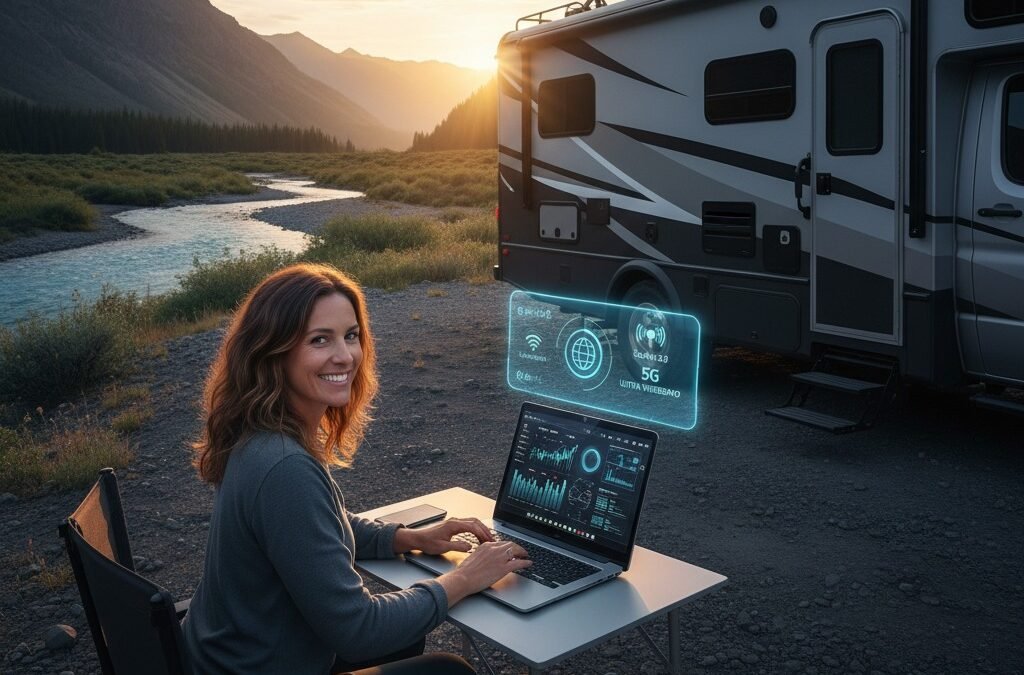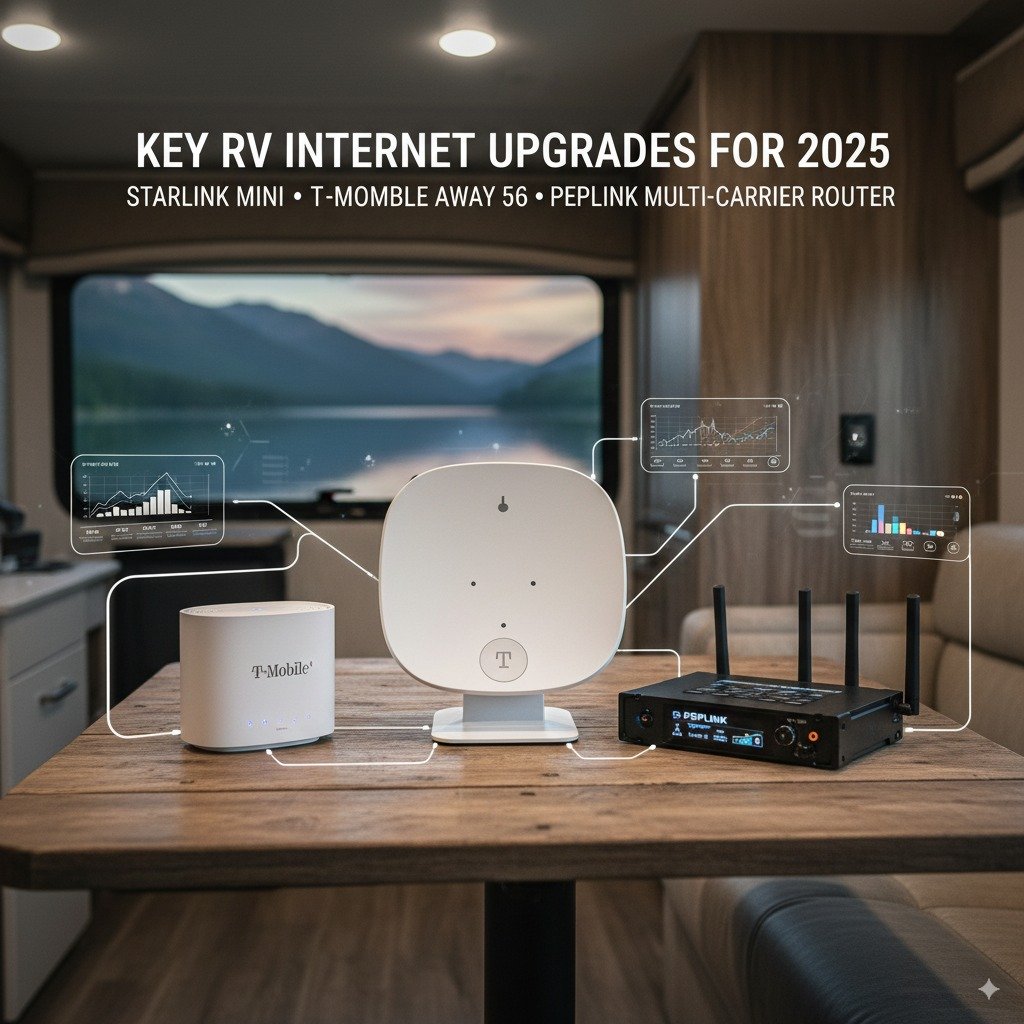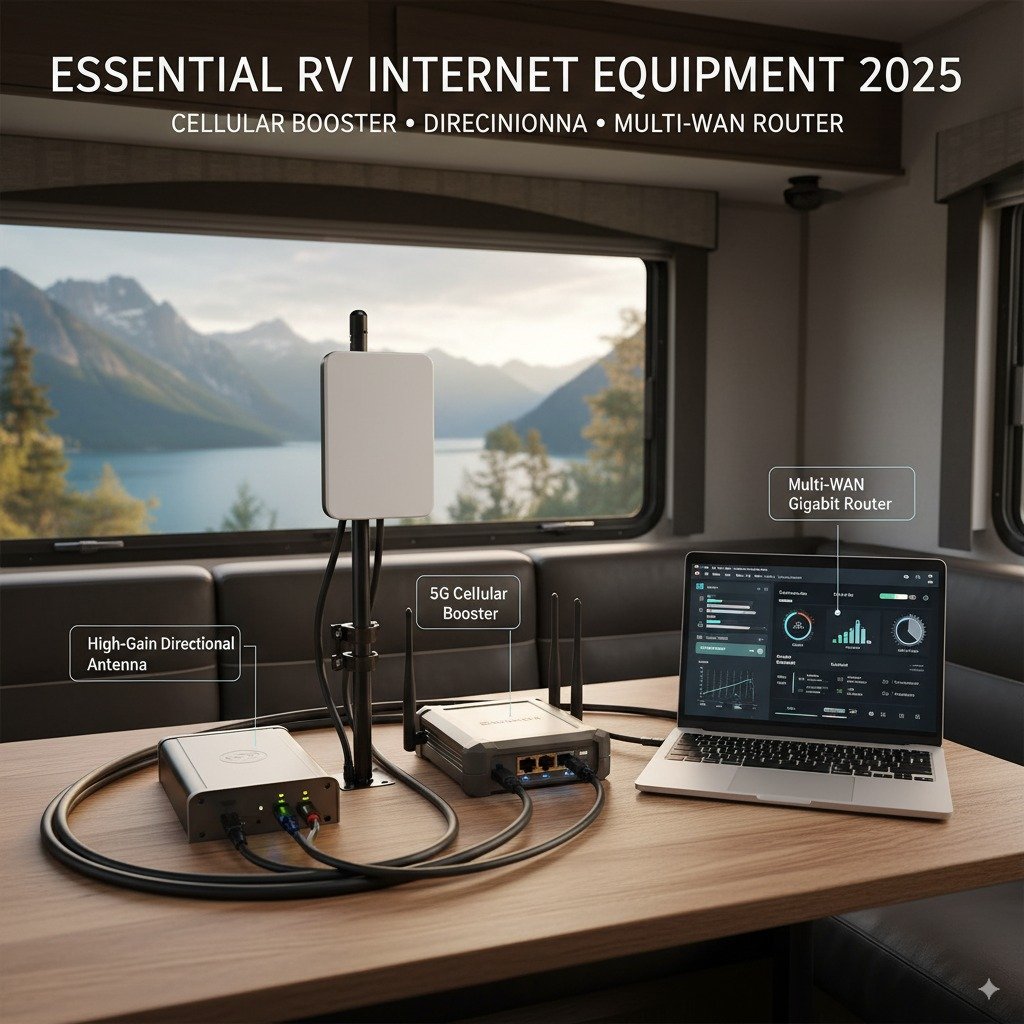Staying Connected on the Road: The Ultimate RV Internet Guide (2025)
By Boondock or Bust Editorial Team • August 31, 2025 • 8-minute read
(TL;DR)
For most RVers in 2025, a dual-path setup—Starlink Roam for remote coverage plus a 5G carrier hotspot (e.g., Verizon/AT&T/T-Mobile)—delivers the best mix of availability and performance. Starlink supports in-motion use on eligible plans and fills critical off-grid gaps, while hotspots excel in towns and on interstates with lower power draw. A critical counterpoint, however, is that this dual-system approach represents a significant cost and complexity that may be excessive for casual vacationers. For remote work involving regular video calls, budget for at least a 30–60GB high-speed hotspot data plan.
What’s New in RV Internet for 2025
The mobile internet landscape is constantly shifting. In 2025, the key developments focus on more flexible plans and powerful hardware. T-Mobile’s AWAY plan, for instance, now directly targets the nomadic community with a portable 5G gateway and large data options that can be paused seasonally. However, an informed skeptic would note that this plan’s performance is still subject to network congestion and deprioritization, which can render it slow during peak use in popular areas. On the satellite front, Starlink’s business-class Priority plans shifted to metered high-speed data buckets, eliminating the previous unlimited option for power users.
A key human insight from the field is the growing importance of routers with modern modems. Hardware using Qualcomm’s X65 chipset significantly improves 5G performance, particularly with carrier aggregation, which combines multiple cellular bands for a faster, more stable connection—a tangible benefit when you’re parked in a fringe service area.
Carrier Hotspots (Phone + Dedicated) in 2025
Cellular remains the foundational layer of RV connectivity for its broad availability and ease of use. The primary providers—Verizon, AT&T, and T-Mobile—all offer phone plans with defined high-speed hotspot data pools. For example, as of 2025, AT&T’s Unlimited Premium plan includes 60GB of high-speed hotspot data before speeds are reduced. While convenient, relying solely on a phone hotspot can drain the device’s battery and subject your connection to thermal throttling. A persistent critique of carrier plans is the opaque nature of throttling; speeds after hitting a data cap can be slowed to rates (e.g., 600 kbps) that make modern web browsing nearly impossible.
For this reason, many serious remote workers invest in a dedicated mobile hotspot device. A practical tip is to choose a hotspot from a different carrier than your phone plan to build in redundancy. If you’re in an area where AT&T has no service, your Verizon hotspot might save the workday.
Cellular Plan Snapshot (for RVers)
| Provider | Example Tier (2025) | High-Speed Hotspot Data | Notes |
|---|---|---|---|
| Verizon | Unlimited Plus | ≈30GB, then reduced | Large LTE footprint; verify throttling language. |
| AT&T | Unlimited Premium PL | ≈60GB, then reduced | Clear published hotspot pools. |
| T-Mobile | Go5G Plus / AWAY | Plan-dependent (large) | Mobile-friendly plans; verify local coverage. |
Starlink for RVers (Roam & Mini)
Starlink has become the default solution for connectivity in truly remote, off-grid locations. Its Roam plans are designed for mobile use and can be paused, offering flexibility. While its low-latency performance is excellent for video calls and streaming, it’s not without flaws. The standard hardware has a significant power draw, a major consideration for RVers relying on solar and battery banks. Furthermore, the claim of “work from anywhere” is challenged by the absolute requirement for a wide, clear view of the sky, which can be difficult to find in forested campgrounds or narrow canyons.
The compact Starlink Mini, with its built-in Wi-Fi and lower power consumption, addresses some of these issues, making it a better fit for smaller, battery-first rigs. A crucial piece of user advice is to always use the official Starlink app’s obstruction-checker tool *before* finalizing your campsite to avoid discovering your spot is unusable after you’ve already leveled the RV.
Essential Equipment & Why It Matters
Building a reliable system requires more than just a service plan. A multi-WAN router with Quality of Service (QoS) allows you to blend Starlink and cellular, automatically switching to the best available connection and prioritizing traffic for critical applications like work calls. An external, roof-mounted antenna will almost always outperform an indoor hotspot. A common mistake newcomers make is neglecting to properly seal antenna cable entry points on the roof, leading to water leaks down the road.
Cellular boosters can amplify weak signals but are often misunderstood. They cannot create a signal where none exists and must be registered with your provider. A skeptic’s take is that in many fringe areas, the money spent on a booster would be better invested in a higher-gain directional antenna or put towards a Starlink subscription, which solves the “no signal” problem rather than just improving a poor one.
| Equipment Type | Examples | Why It Helps |
|---|---|---|
| Hotspots | Verizon Jetpack; Netgear Nighthawk M6 | Dedicated modem; saves phone battery; better device limits. |
| Antennas | Parsec Husky Pro; Pepwave HDTX | Dramatically improves weak cellular/Wi-Fi signals. |
| Routers (QoS) | Peplink Balance; GL.iNet Beryl AX | Prioritizes traffic (e.g., Zoom) and provides failover. |
| Boosters | weBoost Drive Reach RV | Amplifies *existing* weak cellular signals. |
FAQ
Is Starlink better than cellular for RV internet?
Starlink excels where cellular is absent; cellular is more cost-effective and power-efficient where 5G/4G is strong. A combination of both is the most resilient approach, using cellular as the primary link and Starlink for off-grid backup.
Can I use my home internet plan in my RV?
It is not recommended. Fixed 5G home plans have location restrictions in their terms of service, and providers are increasing enforcement. Mobile-specific plans like T-Mobile AWAY or Starlink Roam are designed and authorized for travel.
How can I improve a weak cell signal?
The most effective method is a roof-mounted external antenna connected to a mobile router. A carrier-approved booster can also help by amplifying an existing signal, but it must be registered and cannot create a signal where there is none.
Conclusion
The most resilient RV internet strategy for 2025 is built on redundancy. It blends Starlink for truly remote coverage with a high-speed carrier hotspot for towns, highways, and better power efficiency. Anchoring this with a capable QoS router allows you to manage traffic and failover seamlessly. While this approach requires a higher initial investment, it provides the peace of mind needed for reliable remote work and modern connectivity on the road.
References
- AT&T. (2025, Jan 7). Explore Unlimited Your Way: Hotspot data info. Retrieved from https://www.att.com/support/article/wireless/KM1182926/
- AT&T. (2024, Jul 17). Use your device’s hotspot. Retrieved from https://www.att.com/support/article/wireless/KM1009376/
- Mobile Internet Resource Center. (2025, Mar 19). Starlink changes Priority plans—unlimited high-speed eliminated. Retrieved from https://www.rvmobileinternet.com/
- Mobile Internet Resource Center. (2025, Mar 20). Peplink MAX BR2 Pro X65. Retrieved from https://www.rvmobileinternet.com/
- MobileMustHave. (2025). Peplink MAX BR2 Pro (X65). Retrieved from https://mobilemusthave.com/
- NASA. (2023). Rain fade. Retrieved from https://www.nasa.gov/
- Norton. (2023). 2023 Cyber Safety Insights Report. Retrieved from https://www.nortonlifelock.com/
- SpaceX / Starlink. (2024–2025). Roam plans & in-motion use. Retrieved from https://www.starlink.com/
- T-Mobile. (2024–2025). AWAY plan / Internet for RVs & Campers. Retrieved from https://www.t-mobile.com/
- Verizon. (2025). myPlan: Unlimited & Important plan information. Retrieved from https://www.verizon.com/
- Federal Communications Commission. (2021). Signal boosters. Retrieved from https://www.fcc.gov/




